01: Lure Choice
Between The Lines - Ch 06: Lure Introduction
|
Until we can interview a gamefish we really don't know why lures do catch fish, but catch fish they do, often more and bigger fish than any other method used. It is also apparently not all lures are equal - some lures and colours consistently catch much more fish than others. It appears they successfully trigger feeding and aggression responses. In the wild world of a predator, anything that moves and is easily caught is probably edible. The more a lure looks like something a fish is used to eating and the more wounded it appears, the more likely it will commit precious energy to an attack. Just as a cat will attack anything that moves within range in a natural hunting response. Essentially, the factors that contribute to the effectiveness of a lure are size, shape, colour, vibration, action, rigging and of course, the often overlooked fact of using them in an area likely to produce results. The types of lure we are specifically discussing are surface-running skirted trolling lures, although much of the theory has relevance to other types of lures and forms of fishing. When trolled behind the boat, they tend to 'work' in a repetitive cycle. (Vid 1) It comes to the surface, grabs air 'breathing', and dives down leaving a long bubble trail, 'smoking' and when it stops smoking, it comes up for another breath. It should not run under the water without a smoke trail for any length of time, if it does it is dubbed 'lazy'. Also, it shouldn't come out of the water, 'blowing out' when it comes up to breathe.
All the different shapes and sizes go through these motions with different levels of aggression and timing. For example, for many sliced-headed lures the cycle is repeated every 15 seconds, and some as long as 30 seconds between breaths. Pakula Lures are at their best when they breathe every 5 seconds. Some come to the surface and softly breathe before diving; others explode on the surface causing a sonic boom. They can dive as straight as an arrow, while others may 'swim' off to the side or dive in a deep consistent arc, while others shake their heads or tails as they dive. Smoke trails vary from pencil thin to almost creating their own prop wash. This largely depends on the shape of the lure head, overall lure length and trolling speed. How often a lure goes through the working cycle depends on lure design, sea conditions, boat speed, lure position, line class and rigging. Lure selection is based on the level of information you have at hand, varying from a recommendation by your local tackle store or anglers fishing in the same areas, or perhaps recommendations from manufacturers, web forums, and indeed from personal preferences based on your own experiences. Care should be taken if you incorporate individual lure recommendations to form a lure pattern. Think of it as getting advice for car parts, you could end up with an economical 1200cc engine, four-wheel-drive diffs, balloon tyres and a comfortable LTD body. All great as separate items, but when they're put together, it's a bit of a disaster.
When trolling skirted lures we troll a number of them at the same time. These are deployed into a 'pattern' with positions that have been given specific names, most often four to six lures, but many more can be run at the same time using individual outfits. (Fig 1) The pattern is, to put it simply, a guide to where the lures are run so when the boat is turned they don't tangle. As we progress we'll go into this subject in greater detail. Deciding how many lures you wish to run and the line classes involved depends on the following. In areas where the fish are in great numbers, or there is a small crew to handle the gear, the number of lures is less than in areas where there are less fish or more crew. For example, in Cairns, many boats may troll only two lures. In other areas, up to ten lures and a brace of up to six teasers are used at the same time.
Although we haven't yet ventured out on the seas, the 'Strike Zone' or the area of the wash most lures catch fish successfully is the area from the back of the boat to the end of the wash or turbulence. (Fig 2) To enhance this we select lures from highly aggressive and large near the back of the boat to more sedate and smaller as we get to the end of the prop wash. The greater the range of sizes used the more species of fish you are likely to target. For example, a five lure spread would consist of one 14-inch, one 12-inch, two 10-inch and an 8-inch lure. There may be times when you may wish to eliminate smaller species such as skipjack or bonito, in which case you wouldn't run lures less than 8-inches.
Lure patterns are three-dimensional incorporating length, width and height. Length is used to position the lures between the back of the boat to the end of the prop wash. Width is used to spread the lures out to not only cover more ground but to position lures in more likely areas of the wash. Height is adjustable through the use of rod holder positions, rod length, outriggers and other systems to regulate height, or the angle that the line and lure enter the water. The higher the angle to the water the more aggressive the lure action is. Even though we have the ability to make large and fine adjustments to lure positioning, lures are designed to run in specific positions which relate to the angle of entry. To explain this further the Pakula Lure heads fall into the following categories: - The longer the head and the smaller the face the longer the position.
- The shorter the head and the wider the face the shorter the position.
- If a head is both long and has a wide face the more likely it is to work in all positions as it will have a more aggressive action and best used in a short position.
Over the years four colour groups have accounted for the highest catch statistics. More than that, these colours would appear to have certain best positions in the spread. These factors add up to make a backbone applicable to any blue water lure pattern. I've noted the colour groups in specific positions in the pattern. Short Corner: The largest lure in the pattern is black. As it is run closest to the boat and positioned in the most turbulent part of the wash, the dark silhouette shows up clearly. In reality, most bait species are well camouflaged, so regardless of what colour a lure is, it will show up clearly no matter where it is run. Even if it were invisible the vibrating action would be felt by the fish's lateral line making it easy to track down. The main combinations are black over pink, black over purple, and black over green. In some patterns, you may wish to substitute a very bright pink or orange combination in this position. Long Corner: The next lure in the pattern is the second largest and it is a blue combination such as blue and silver over green and gold, blue and silver over pink or blue and pearl white over pink and white. Short Rigger: The most successful colour in this position is purple with combinations of blue and black. Long Rigger: Without a doubt, the best colour for this position is green preferably Lumo Green over green and chartreuse. The above colour groups in their specific positions have more than proven their effectiveness over many years, successfully replacing many game fishing areas' traditional 'hot colours'. This set of colours matches the most common baitfish colours found in all game fishing areas around the world. You will also see that these colours range from very bright to very dark, giving maximum variation in their silhouettes. The fifth lure on the shotgun and any supplementary lures in various other positions are the 'try out' lures. This is also where you should run an area's own particular 'hot colour' for example black and red or yellow around tropical reefs, pink in the light tackle fisheries in Australia. Any lures you wish to try out in new colours or shapes should be run in these positions.
|





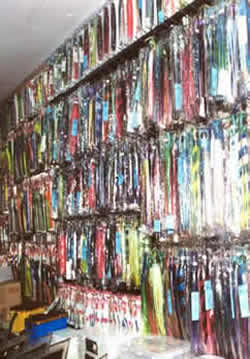 Bits of moulded plastic with tassels on the end brimming with sparkling razor-sharp hooks are essentially what lures are. Many even look like pieces of hand-crafted jewellery, others like mass-produced junk. Hanging on a rack in a shop lures do not look like anything that has ever lived anywhere on the planet. It is not until they are put to work that they take on a lifelike action that both fish and fishermen find irresistible.
Bits of moulded plastic with tassels on the end brimming with sparkling razor-sharp hooks are essentially what lures are. Many even look like pieces of hand-crafted jewellery, others like mass-produced junk. Hanging on a rack in a shop lures do not look like anything that has ever lived anywhere on the planet. It is not until they are put to work that they take on a lifelike action that both fish and fishermen find irresistible.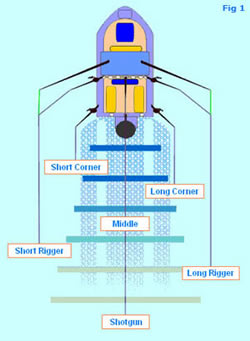 When choosing lures we tend to specify them according to the species of fish we most desire to catch, such as blue marlin lures, sailfish lures, Tuna lures, and wahoo lures etc. Unfortunately, this method of classification is not only incorrect, it is often misleading. A lure pattern should imitate a selection of wounded or fleeing bait species that are likely to be in the area at the time you are fishing. As most predators will feed on any available food source, you will target whatever predatory species are around from small tuna to monster billfish. Therefore lures should be thought of as bait not predator-specific.
When choosing lures we tend to specify them according to the species of fish we most desire to catch, such as blue marlin lures, sailfish lures, Tuna lures, and wahoo lures etc. Unfortunately, this method of classification is not only incorrect, it is often misleading. A lure pattern should imitate a selection of wounded or fleeing bait species that are likely to be in the area at the time you are fishing. As most predators will feed on any available food source, you will target whatever predatory species are around from small tuna to monster billfish. Therefore lures should be thought of as bait not predator-specific.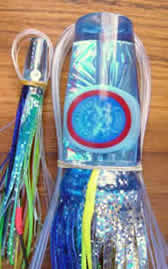 Each line class has a maximum-sized lure that can be effectively trolled, as bigger lures may pull more drag than the safe strike setting on the line class used. There is no minimum-sized lure for any line class, nor is there any optimum-sized lure for any species or size of fish you are chasing. Monsters will eat tiny lures, however, as they are not commonly rigged to catch fish of this size the fish are rarely landed. 'Matching the hatch' is actually quite easy, as the species of blue water bait are very similar throughout the world's game fishing areas, although the bait species change as they migrate through an area
Each line class has a maximum-sized lure that can be effectively trolled, as bigger lures may pull more drag than the safe strike setting on the line class used. There is no minimum-sized lure for any line class, nor is there any optimum-sized lure for any species or size of fish you are chasing. Monsters will eat tiny lures, however, as they are not commonly rigged to catch fish of this size the fish are rarely landed. 'Matching the hatch' is actually quite easy, as the species of blue water bait are very similar throughout the world's game fishing areas, although the bait species change as they migrate through an area 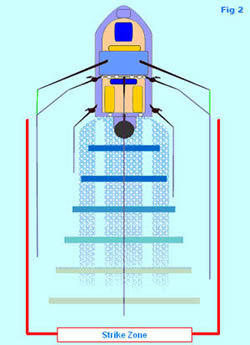 according to seasons and currents. By understanding which food is most likely to be in the area - either from local knowledge or just looking in the local fish shop - you can accurately select a lure that matches the hatch in action, colour and size. There is no doubt that if you get this right you'll even catch the fish you're after outside the period considered to be a normal season.
according to seasons and currents. By understanding which food is most likely to be in the area - either from local knowledge or just looking in the local fish shop - you can accurately select a lure that matches the hatch in action, colour and size. There is no doubt that if you get this right you'll even catch the fish you're after outside the period considered to be a normal season.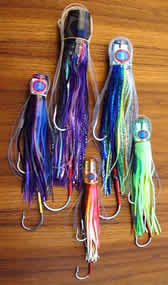 As you gain more experience you'll develop certain patterns for specific sizes of species, line classes, seasons and areas you fish.
As you gain more experience you'll develop certain patterns for specific sizes of species, line classes, seasons and areas you fish.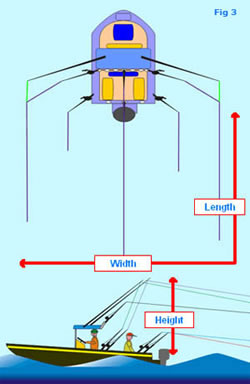 The chosen set of lures should be compatible with each other in action, vibration and effective trolling speed. The simplest way to do this is run lures that are all similar in types, such as all Scoop Faced Chuggers in the Pakula range, or all sliced-head lures. Mixing lure types when you're just starting out is really making the sport far more difficult than necessary. For example, each Pakula Lure is designed to run in specific positions within a pattern. Knowing where this position is, by just looking at the lure without a great deal of experience, is very difficult.
The chosen set of lures should be compatible with each other in action, vibration and effective trolling speed. The simplest way to do this is run lures that are all similar in types, such as all Scoop Faced Chuggers in the Pakula range, or all sliced-head lures. Mixing lure types when you're just starting out is really making the sport far more difficult than necessary. For example, each Pakula Lure is designed to run in specific positions within a pattern. Knowing where this position is, by just looking at the lure without a great deal of experience, is very difficult. 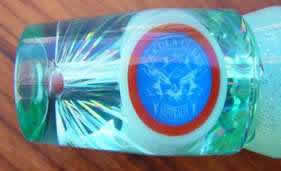
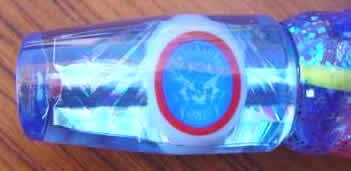
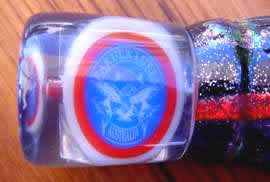
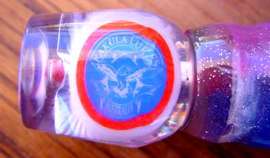
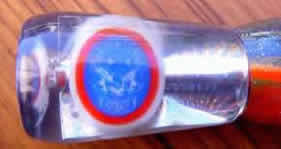 As mentioned previously it is important to place the more aggressive and active lures closer to the boat. If this simple rule is not followed and you put the larger or more aggressive lures at the tail of the pattern you can set up a 'Blocking Pattern'. Many fish will not go past a larger lure to attack a smaller one.
As mentioned previously it is important to place the more aggressive and active lures closer to the boat. If this simple rule is not followed and you put the larger or more aggressive lures at the tail of the pattern you can set up a 'Blocking Pattern'. Many fish will not go past a larger lure to attack a smaller one.